spare wheel TOYOTA RAV4 2009 XA30 / 3.G Owners Manual
[x] Cancel search | Manufacturer: TOYOTA, Model Year: 2009, Model line: RAV4, Model: TOYOTA RAV4 2009 XA30 / 3.GPages: 516, PDF Size: 10.61 MB
Page 368 of 516

368
4-3. Do-it-yourself maintenance
Tires
Replace or rotate tires in accordance with maintenance sched-
ules and treadwear.
■Checking tires
New tread
Treadwear indicator
Worn tread
The location of treadwear
indicators is shown by the
“TWI” or “ ” marks, etc.,
molded on the sidewall of
each tire.
Check spare tire condition
and inflation pressure if not
rotated.
■Tire rotation
Vehicles with a spare tire of the same wheel type as the installed
tires
Rotate the tires in the order
shown.
To equalize tire wear and
extend tire life, Toyota recom-
mends that tire rotation is
carried out at the same inter-
val as tire inspection.
Front
Page 369 of 516
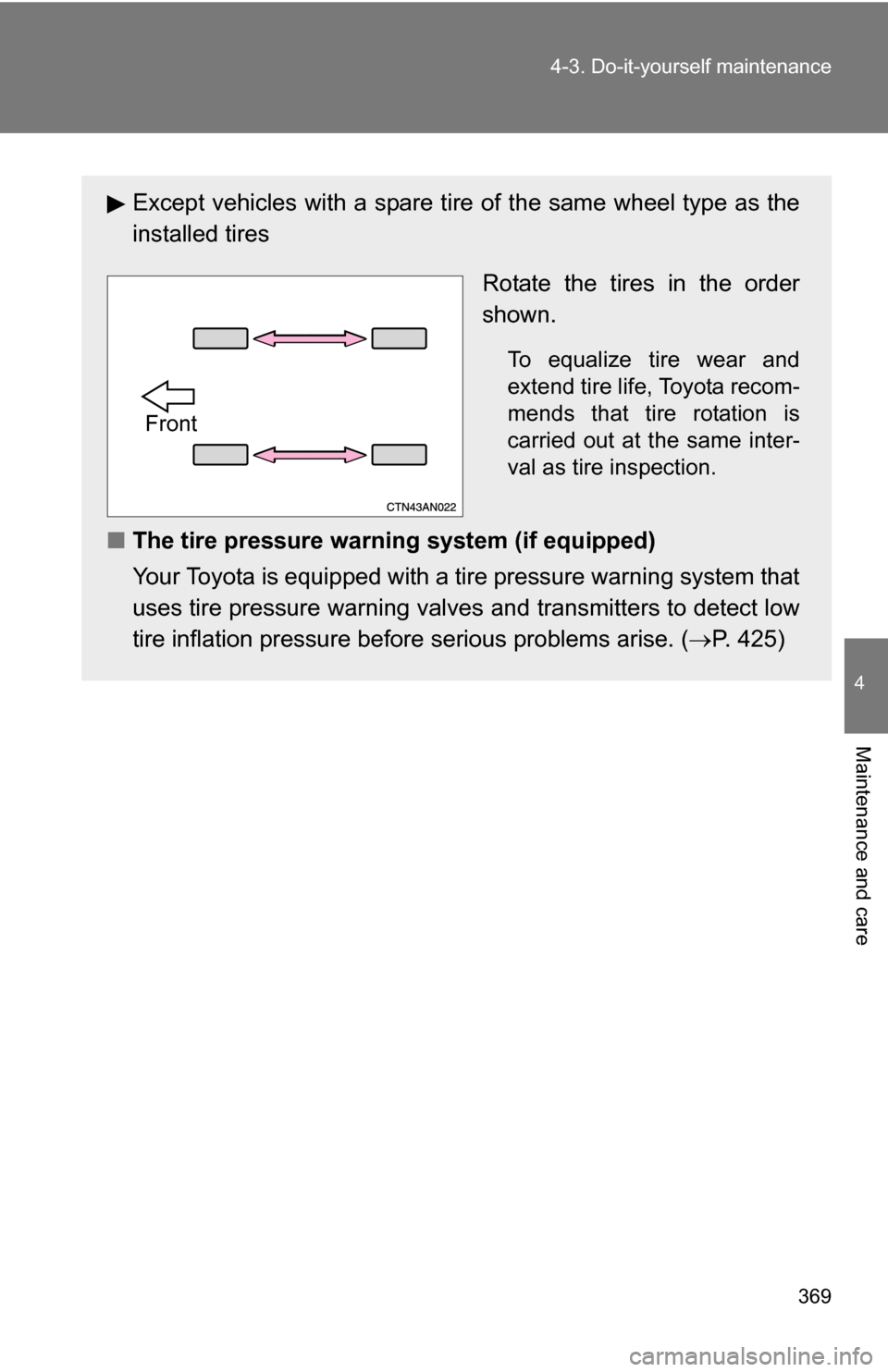
369
4-3. Do-it-yourself maintenance
4
Maintenance and care
Except vehicles with a spare tire
of the same wheel type as the
installed tires
Rotate the tires in the order
shown.
To equalize tire wear and
extend tire life, Toyota recom-
mends that tire rotation is
carried out at the same inter-
val as tire inspection.
■The tire pressure warning system (if equipped)
Your Toyota is equipped with a tire pressure warning system that
uses tire pressure warning valves and transmitters to detect low
tire inflation pressure before serious problems arise. (P. 425)
Front
Page 430 of 516

430 5-2. Steps to take in an emergency
■If the tire pressure warning system is inoperative
The tire pressure warning system will be disabled in the following condi-
tions:
(When the condition becomes normal, the system will work properly.)
●If tires not equipped with tire pressure warning valves and transmit-
ters are used.
●If the ID code on the tire pressure warning valves and transmitters is
not registered in the tire pressure warning computer.
●If the tire inflation pressure is 73 psi (500 kPa, 5.1 kgf/cm2 or bar) or
higher.
The tire pressure warning system may be disabled in the following condi-
tions:
(When the condition becomes normal, the system will work properly.)
●If electronic devices or facilities using similar radio wave frequencies
are nearby.
●If a radio set at similar frequencies is in use in the vehicle.
●If a window tint that affects the radio wave signals is installed.
●If there is a lot of snow or ice on the vehicle, in particular around the
wheels or wheel housings.
●If non-genuine Toyota wheels are used. (Even if you use Toyota
wheels, the tire pressu re warning system may not work properly with
some types of tires.)
●If tire chains are used.
●If the spare tire is in a location subject to poor radio wave signal
reception.
●If a large metallic object which can interfere with signal reception is
put in the luggage compartment.
Page 431 of 516
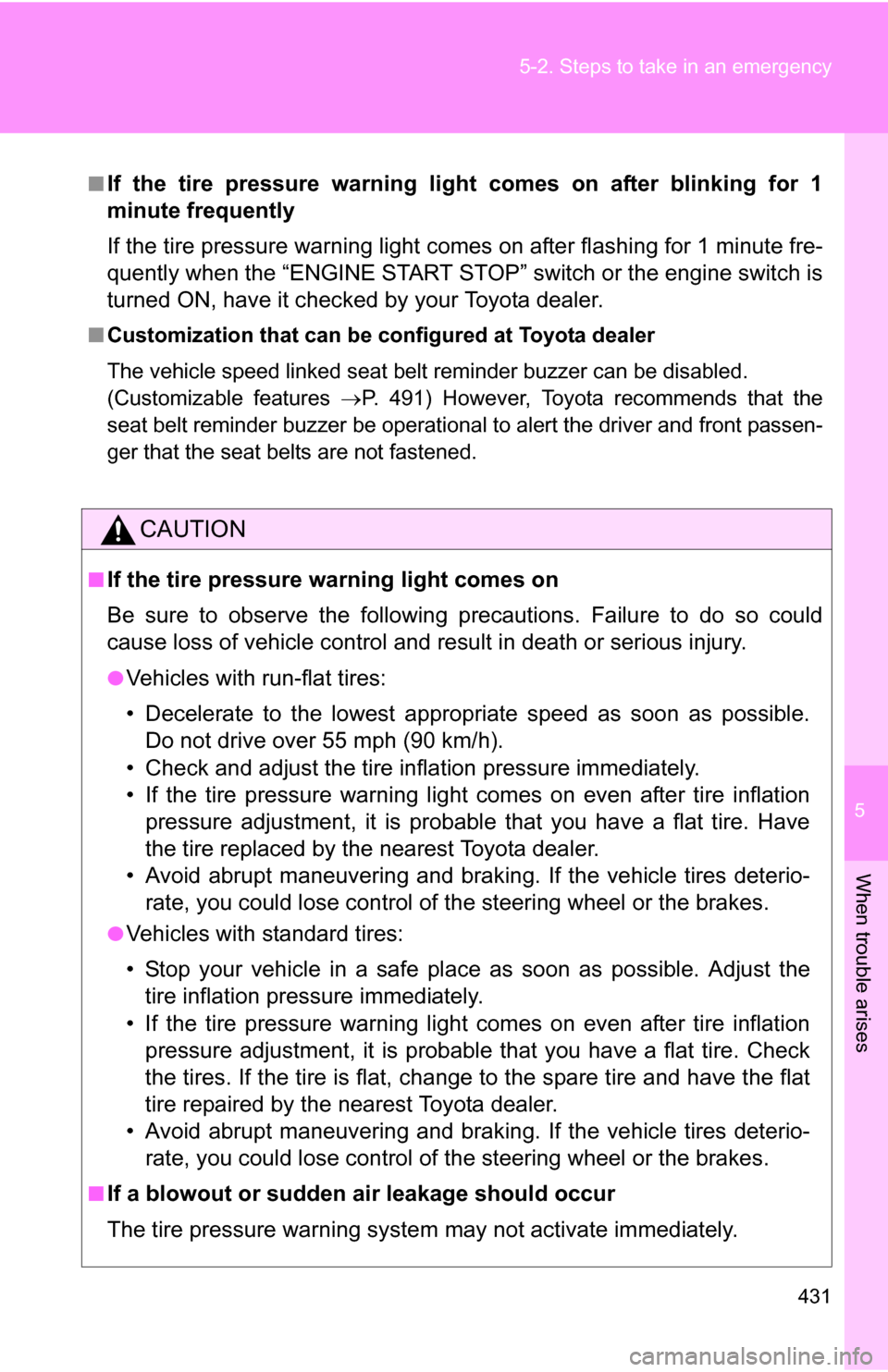
5
When trouble arises
431
5-2. Steps to take in an emergency
■If the tire pressure warning light comes on after blinking for 1
minute frequently
If the tire pressure warning light comes on after flashing for 1 minute fre-
quently when the “ENGINE START STOP” switch or the engine switch is
turned ON, have it checked by your Toyota dealer.
■
Customization that can be co nfigured at Toyota dealer
The vehicle speed linked seat belt reminder buzzer can be disabled.
(Customizable features P. 491) However, Toyota recommends that the
seat belt reminder buzzer be operational to alert the driver and front passen-
ger that the seat belts are not fastened.
CAUTION
■If the tire pressure warning light comes on
Be sure to observe the following precautions. Failure to do so could
cause loss of vehicle control and result in death or serious injury.
●Vehicles with run-flat tires:
• Decelerate to the lowest appropr iate speed as soon as possible.
Do not drive over 55 mph (90 km/h).
• Check and adjust the tire inflation pressure immediately.
• If the tire pressure warning light comes on even after tire inflation pressure adjustment, it is probable that you have a flat tire. Have
the tire replaced by the nearest Toyota dealer.
• Avoid abrupt maneuvering and brak ing. If the vehicle tires deterio-
rate, you could lose control of th e steering wheel or the brakes.
●Vehicles with standard tires:
• Stop your vehicle in a safe place as soon as possible. Adjust the
tire inflation pressure immediately.
• If the tire pressure warning light comes on even after tire inflation pressure adjustment, it is probable that you have a flat tire. Check
the tires. If the tire is flat, change to the spare tire and have the flat
tire repaired by the nearest Toyota dealer.
• Avoid abrupt maneuvering and brak ing. If the vehicle tires deterio-
rate, you could lose control of th e steering wheel or the brakes.
■If a blowout or sudden air leakage should occur
The tire pressure warning system may not activate immediately.
Page 437 of 516

5
When trouble arises
437
5-2. Steps to take in an emergency
Taking out the spare tire (vehicles with the spare tire cover)
Open the back door. Unlock the
latch handle which on the bottom
of the spare tire cover.
Remove the spare tire cover.
When placing the spare tire
cover on the ground, make sure
the cover design side faces up
to avoid scratching the cover
surface.
Close the back door.Using the wheel nut wrench,
loosen the hold-down nuts by
turning them counterclockwise
until they can be loosened by
hand. Follow the order shown in
the illustration.
Remove all the wheel nuts and the spare tire.
When placing the spare tire on the ground, make sure the wheel
design side faces up to avoid scratching the wheel surface.
STEP 1
STEP 2
STEP 3
STEP 4
STEP 5
Page 438 of 516

438 5-2. Steps to take in an emergency
Taking out the spare tire (vehicles without the spare tire cover) Using the wheel nut wrench,
loosen the hold-down nuts by
turning them counterclockwise
until they can be loosened by
hand. Follow the order shown in
the illustration.
Remove all the wheel nuts and the spare tire.
When placing the spare tire on the ground, make sure the wheel
design side faces up to avoid scratching the wheel surface.
STEP 1
STEP 2
Page 444 of 516
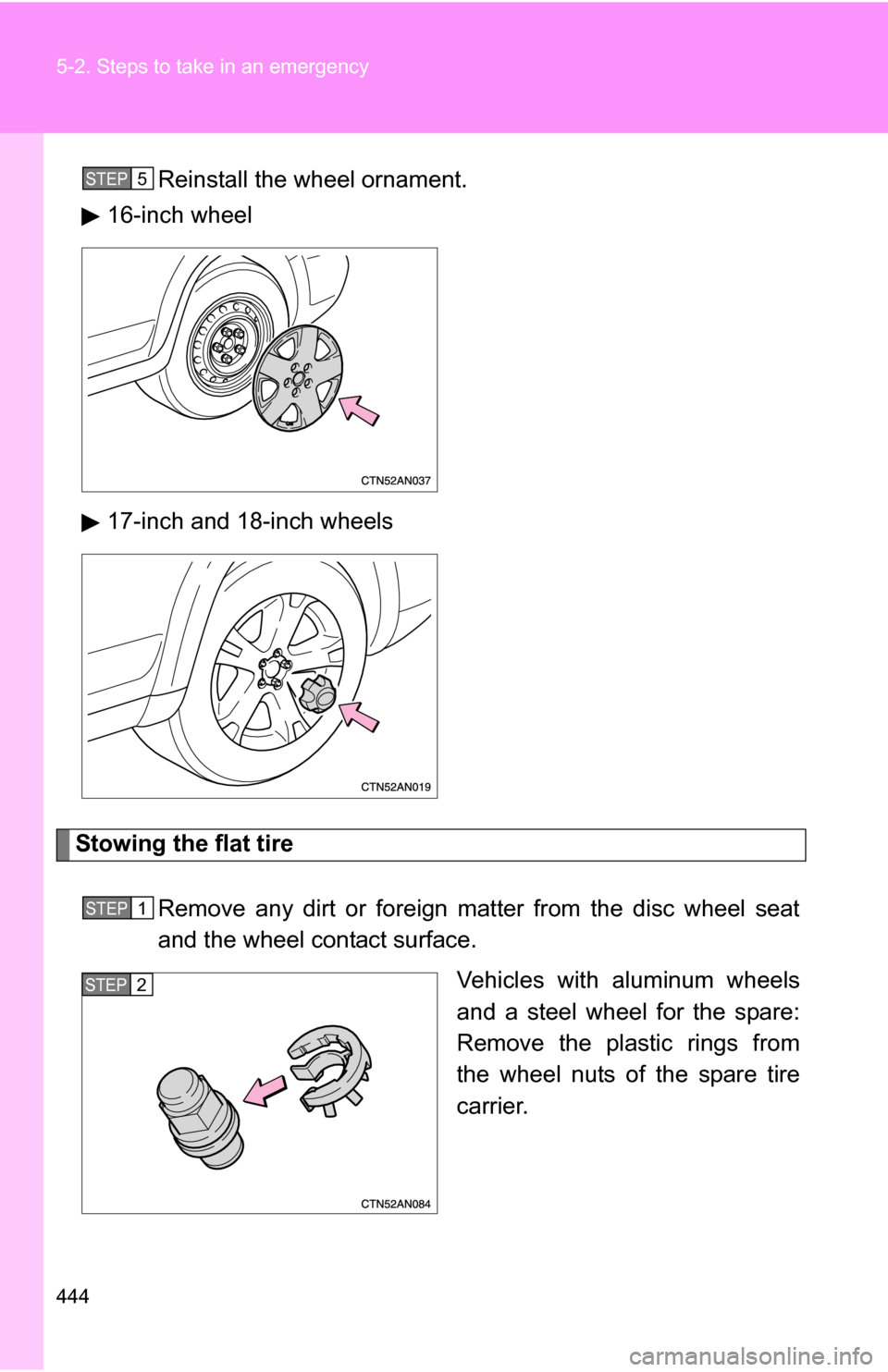
444 5-2. Steps to take in an emergency
Reinstall the wheel ornament.
16-inch wheel
17-inch and 18-inch wheels
Stowing the flat tire
Remove any dirt or foreign matter from the disc wheel seat
and the wheel contact surface. Vehicles with aluminum wheels
and a steel wheel for the spare:
Remove the plastic rings from
the wheel nuts of the spare tire
carrier.
STEP 5
STEP 1
STEP 2
Page 445 of 516
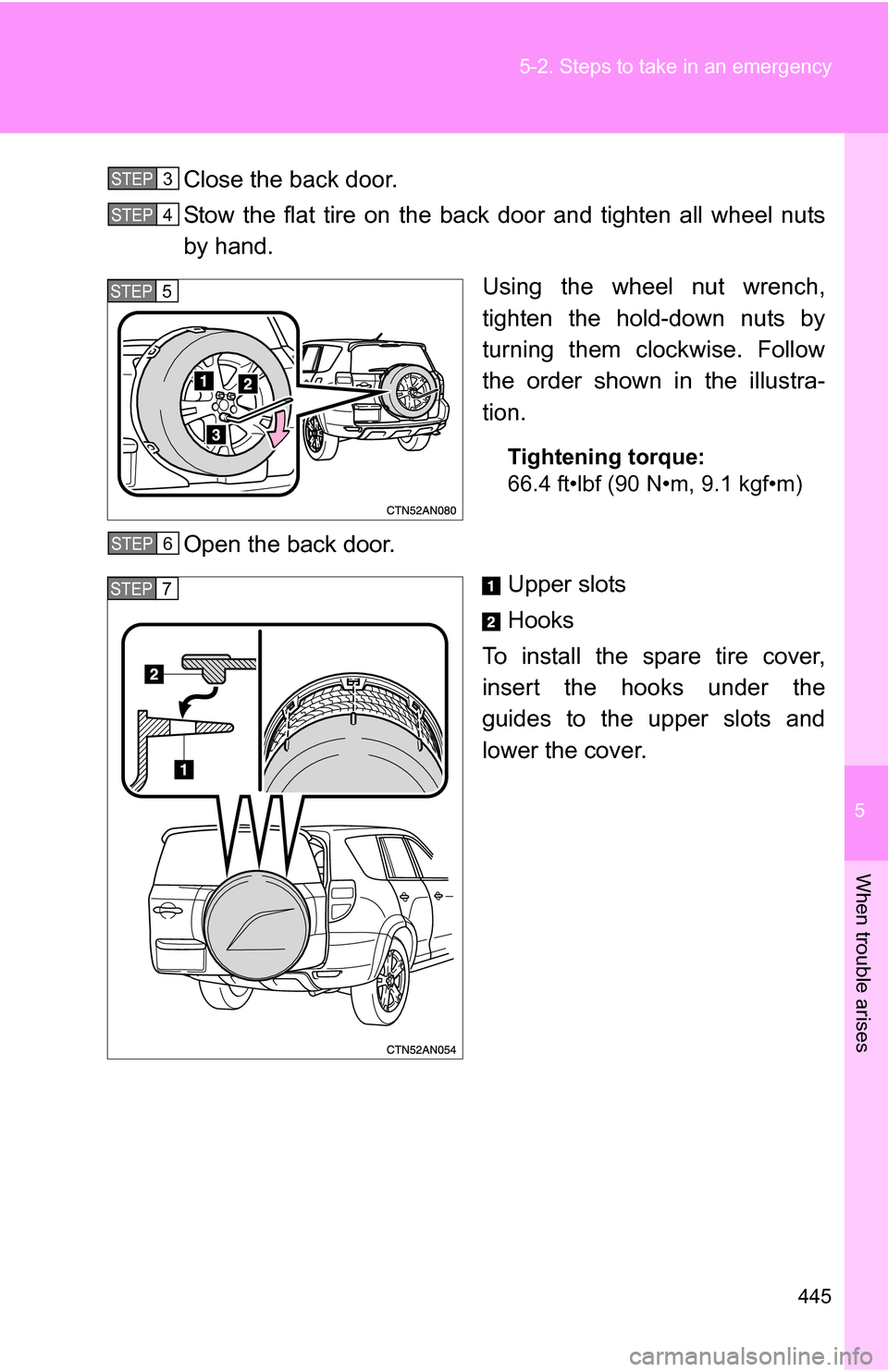
5
When trouble arises
445
5-2. Steps to take in an emergency
Close the back door.
Stow the flat tire on the back door and tighten all wheel nuts
by hand.
Using the wheel nut wrench,
tighten the hold-down nuts by
turning them clockwise. Follow
the order shown in the illustra-
tion.
Tightening torque:
66.4 ft•lbf (90 N•m, 9.1 kgf•m)
Open the back door. Upper slots
Hooks
To install the spare tire cover,
insert the hooks under the
guides to the upper slots and
lower the cover.
STEP 3
STEP 4
STEP 5
STEP 6
STEP 7
Page 447 of 516
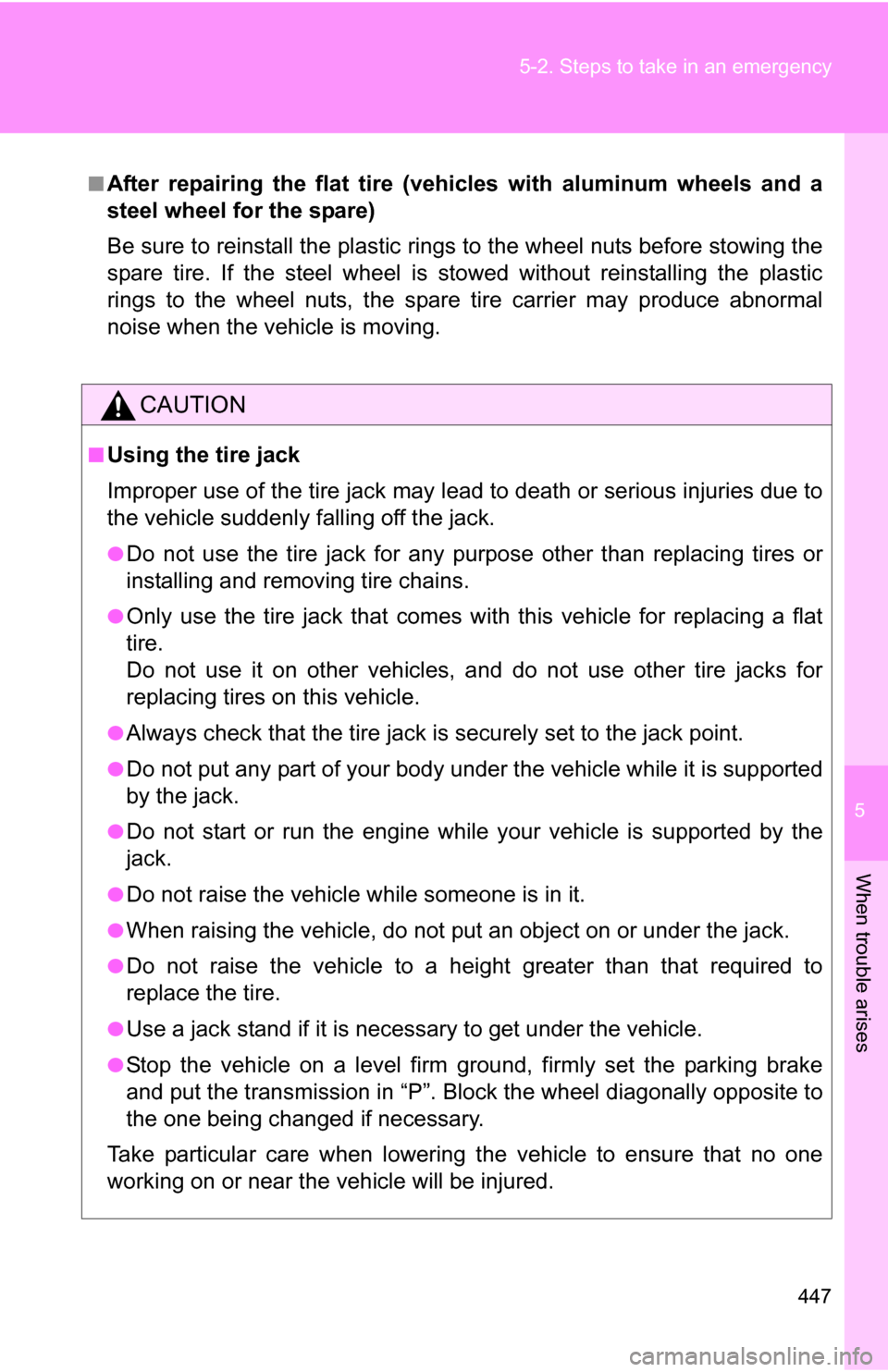
5
When trouble arises
447
5-2. Steps to take in an emergency
■After repairing the flat tire (veh
icles with aluminum wheels and a
steel wheel for the spare)
Be sure to reinstall the plastic rings to the wheel nuts before stowing the
spare tire. If the steel wheel is st owed without reinstalling the plastic
rings to the wheel nuts, the spare tire carrier may produce abnormal
noise when the vehicle is moving.
CAUTION
■Using the tire jack
Improper use of the tire jack may lead to death or serious injuries due to
the vehicle suddenly falling off the jack.
●Do not use the tire jack for any pu rpose other than replacing tires or
installing and removing tire chains.
●Only use the tire jack that comes wi th this vehicle for replacing a flat
tire.
Do not use it on other vehicles, and do not use other tire jacks for
replacing tires on this vehicle.
●Always check that the tire jack is securely set to the jack point.
●Do not put any part of your body under the vehicle while it is supported
by the jack.
●Do not start or run the engine while your vehicle is supported by the
jack.
●Do not raise the vehicle while someone is in it.
●When raising the vehicle, do not put an object on or under the jack.
●Do not raise the vehicle to a hei ght greater than that required to
replace the tire.
●Use a jack stand if it is necessary to get under the vehicle.
●Stop the vehicle on a level firm ground, firmly set the parking brake
and put the transmission in “P”. Block the wheel diagonally opposite to
the one being changed if necessary.
Take particular care when lowering the vehicle to ensure that no one
working on or near the vehicle will be injured.
Page 475 of 516
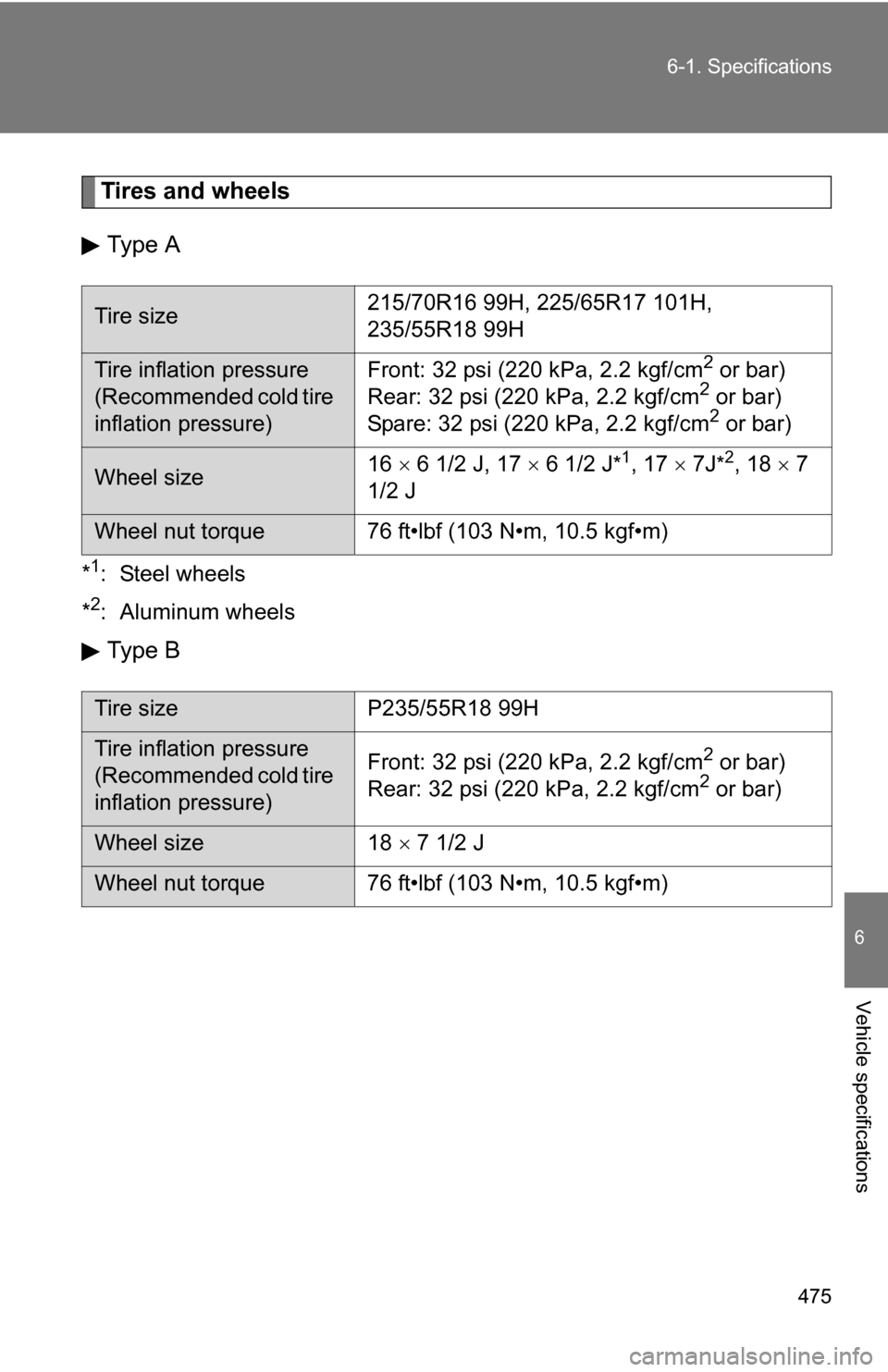
475
6-1. Specifications
6
Vehicle specifications
Tires and wheels
Type A
*1: Steel wheels
*
2: Aluminum wheels
Type B
Tire size 215/70R16 99H, 225/65R17 101H,
235/55R18 99H
Tire inflation pressure
(Recommended cold tire
inflation pressure)Front: 32 psi (220 kPa, 2.2 kgf/cm2 or bar)
Rear: 32 psi (220 kPa, 2.2 kgf/cm2 or bar)
Spare: 32 psi (220 kPa, 2.2 kgf/cm2 or bar)
Wheel size 16
6 1/2 J, 17 6 1/2 J*1, 17 7J*2, 18 7
1/2 J
Wheel nut torque 76 ft•lbf (103 N•m, 10.5 kgf•m)
Tire size P235/55R18 99H
Tire inflation pressure
(Recommended cold tire
inflation pressure) Front: 32 psi (220 kPa, 2.2 kgf/cm2 or bar)
Rear: 32 psi (220 kPa, 2.2 kgf/cm2 or bar)
Wheel size 18 7 1/2 J
Wheel nut torque 76 ft•lbf (103 N•m, 10.5 kgf•m)